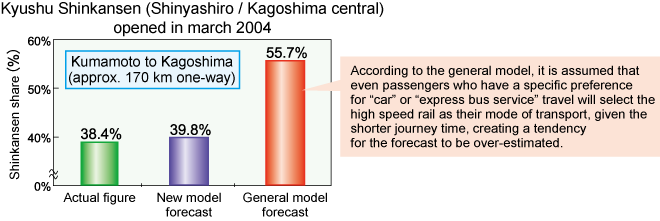3. Transport mode choice model factoring in transport mode preference
- A transport mode choice model was developed, taking into account travellers who use only one type of transport due to specific preferences.
- This new model should permit more accurate estimation of demand trends for Shinkansen and express train services.
Demand forecasting up until now estimated the share of each travel mode in the transport of leisure travellers between cities, and was generally based on a transport mode choice model based on the assumption that all travellers chose their means of travel on a trade-off between journey time and fare price.
It has become clear however that in reality there are many travellers who have a specific preference and use only one type of transport. Consequently, a questionnaire-survey was carried out concentrating on competing transport modes for journeys of 100-300 km, i.e. high speed rail (Shinkansen and express services), car travel and express bus services. Subsequently, 1) on the basis of preference data collected, respondents were placed into two groups depending on whether they had a preference for only one mode of transport or not, and 2) the respondent selected travel means from an array of competing modes, comparing journey time and price. The latter approach was developed into a two stage decision-making new transport mode choice model (Fig 1).
Verification of the present model against three transport modes – high speed rail, car and express bus services – between a range of different destinations, confirmed that estimation of the change in share for each transport mode could be predicted much more accurately (Fig 2).
Consequently, this model can be used to obtain more accurate forecasting of demand trends for Shinkansen and Express train services for distances where they compete with other modes of transport.
 Fig. 1 Outline of new transport mode choice model
Fig. 1 Outline of new transport mode choice model Fig. 2 example of verification of accuracy of estimation of transport mode share (leisure travel)
Fig. 2 example of verification of accuracy of estimation of transport mode share (leisure travel)